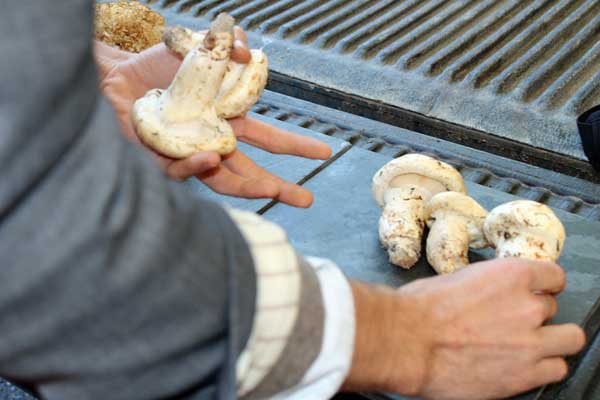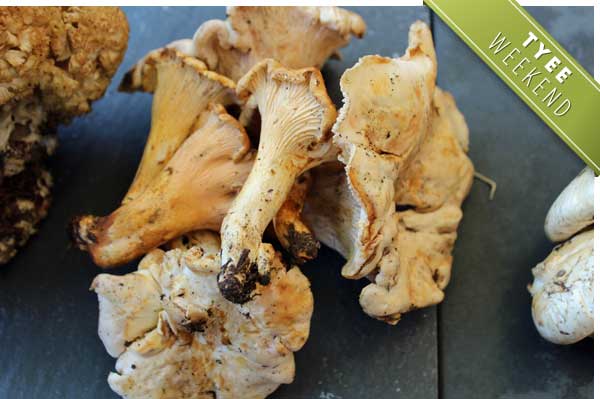It's been a banner year for British Columbia's wild mushroom foragers. And with one month left in the high season, there's still money to be made.
"Last year was a very small harvest. Almost a write-off," recalls Alexander McNaughton, a 25-year-old forager who sells wild delicacies to more than a dozen Vancouver restaurants and markets. "This year has been exceptional for picking, a one-in-eight year."
It takes a certain eye to spot edible fungi under the leaves and moss of a forest floor, he tells me. Those who see business opportunities popping up through the underbrush can bank up to $500 on a good day. "I pick about 100 pounds per week," McNaughton says. "A combination of chanterelles, cauliflower and pine mushrooms."
Though I've never come close to matching McNaughton's picking prowess, I do have some idea what he's talking about, having joined the trendy hordes who've taken up mushroom picking as a way to pump up soups, omelettes and lasagnas. Over the last three years, I've infrequently enjoyed self-harvested chanterelles, oyster mushrooms, angel wings and boletes.
Depending on the mushroom species, the right conditions can include anything from elevation to weather patterns to the most recent forest fire. McNaughton, who learned to forage as a first-grader growing up in Comox Valley, B.C., looks to the trees for subtle hints. "There's cones on all the trees; they call it a seed year," he explains. "Trees have a symbiotic relationship with mushrooms. The trees are putting out growth hormones that trigger the mushrooms to grow."
A 'pick to order' approach
McNaughton's business differs from that of the ordinary forest hunter, as he serves a specific farm-to-table niche. "I pick to order for local chefs in town," he explains. About twice a week McNaughton and a picking buddy drive down unnamed logging roads and hike from dawn until dusk, revisiting areas they've scouted on previous trips.
But before they even get in the car, McNaughton ensures his pickings already have a gourmet destination. "I'll let [the chefs] know what's next with a text message, then I'll go out picking for 12 hours up in Pemberton and deliver the next day."
Representing an emerging generation of foodies within the fungi-finding industry, McNaughton isn't satisfied with the standard business model for mushrooms.
Field buyers are different, he explains. They're distributors that store tens of thousands of pounds from specific bioregions like the Sunshine Coast or Nakusp. "They buy from pickers all over the Nass Valley or Smithers for much less than you would pay in the city." Much-desired pine mushrooms, also known as matsutakes, will sell for only $8 per pound to a distributor, then get marked up to $24 a pound or higher at Vancouver farmers' markets.
"Those mushrooms could be sitting in a fridge for a week or more," he says of distributors' stock. "They could get damaged or wormed or slimy."
Charmed by smaller units and next-day delivery, trendy restaurants like Fable, Acorn, Wildebeest, Graze, the French Table and Forage are choosing McNaughton over a middleman. "My clients will tell me their fridge smells like apricots, like forest, like everything a mushroom should smell like," he says.
Who knew that a freshly picked chanterelle smelled of apricot? No wonder hobby hunting is catching on like morels after a wildfire.
Off the beaten path
For beginners, it's best to get a colourful and inclusive guidebook that chooses the term "not recommended" rather than "poisonous" wherever possible. (It's less intimidating that way.) It feels good to test a few rudimentary rules with your hands: boletes are spongy under the cap, and chanterelles can be peeled like a cheese string.
McNaughton knows about hobby hunters like me, and has incorporated us into his small business. Last year he began teaching mushroom identification with Burnaby Food First and Robin Kort of Swallow Tail Tours.
Most parks don't allow you to pick, so it's tough to find a good spot to practice near the city. On a recent afternoon on the North Shore, after nearly taking a tumble over a fallen tree in a steep gully, I came to terms with the immense physicality required to forage full time.
"It's a physical job," McNaughton says. "I'll be carrying 65 pounds of mushrooms on my back over 2,600 feet of elevation. It's not a straightforward A-to-B climb, you're zig-zagging across slopes, scaling ridges and gullies."
Some of McNaughton's students make the same rookie mistakes I do -- wearing the wrong footwear, or simply failing to keep their wits about them with their eyes glued to the forest floor. "There are a lot of novices out there. They try my patience sometimes," he says. "They love the idea [of mushroom hunting] because they read about foraging in the Globe and Mail. They think it's 'cute.' It's not a walk in the park. It's really hard."

While some may be tempted to set out with a guidebook in search of a quick buck, there are serious risks to consider beyond a misidentified death cap. The regular perils of hiking -- bears, injury and becoming disoriented -- are amplified on a mushroom search.
"You need to respect the forest and come prepared to walk out in a survival situation."
No 'walk in the park' for professional pickers
For those who make a living picking mushrooms, the dangers of the job cannot be taken lightly. Last month, two mushroom pickers in Terrace B.C. went missing for two weeks, sparking an extensive search and rescue mission. One of the pickers, Ike Murray, was found alive near CN rail tracks on Oct. 8, while his friend Michael Devlin Sabo was found dead the next day.
"Most searches are nowhere near this challenging," says Don Bindon, president of the British Columbia Search and Rescue Association (BCSARA). Bindon says locating a mushroom forager is one of the toughest jobs for his search and rescue team. They can be much longer than other searches, and can cover a lot of ground.
Of the 1,200 search and rescue missions in B.C.'s wilderness each year, Bindon estimates between 15 and 25 are mushroom pickers. "We get some every year," he says. "Enough that I know about them. They're on our radar."
Part of the challenge is guessing where foragers' secret mushroom territory might be. "Normally we're able to narrow down an ordinary hiker because they're not heading out for any kind of distance and they're likely to be impeded by natural hazards," says Bindon.
"For instance, most don't go uphill across a mountain range, river or road," he says. "But someone who picks mushrooms each year will have their secret places they like to go, and will try to keep others from learning where those are."
"As a result that person could travel larger distances, and things that stop regular hikers won't stop them."
McNaughton agrees that pickers can be extremely secretive and territorial. "At the farmers' markets the first question people ask is 'Where did you get those?' I might reply with a blank stare," he says, "or just 'deeper than you'll ever go.'"
Beyond bringing the survival essentials, Bindon says the most important thing for pickers is to file a trip plan -- a practice McNaughton generally follows.
"I'll send my girlfriend a text just before we lose cell signal to say 'I'll be going near this mile marker down that logging road and will be back in service area by 8 o'clock,'" he says. "That way if I get hurt she'll know to call for help."
In bountiful seasons like this, the risks are well worth the rewards.
"Coming up we'll have winter chanterelles," says McNaughton of his upcoming pickings. Depending on the weather, he also predicts another flush of the golden variety B.C. is renowned for. "I'll still get cauliflower, winter oysters, pines, some wild ginger, wild greens like sorrel and spinach into November." ![]()
Read more: Food, Labour + Industry
















Tyee Commenting Guidelines
Comments that violate guidelines risk being deleted, and violations may result in a temporary or permanent user ban. Maintain the spirit of good conversation to stay in the discussion.
*Please note The Tyee is not a forum for spreading misinformation about COVID-19, denying its existence or minimizing its risk to public health.
Do:
Do not: